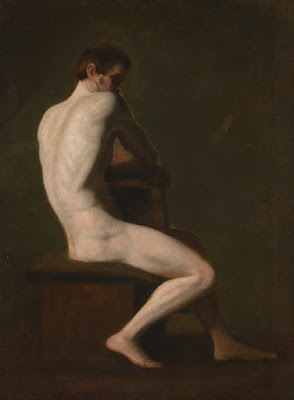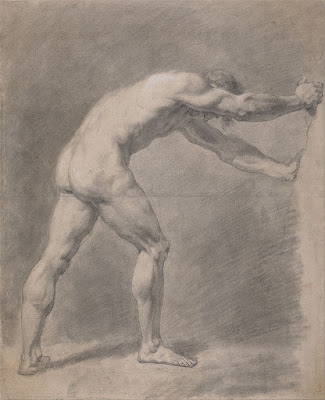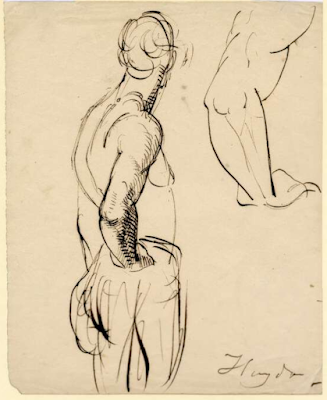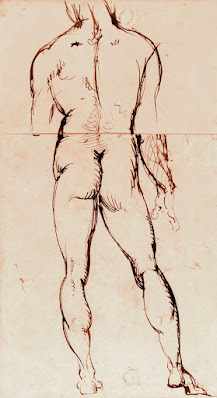 |
| John Constable Model Seated ca. 1810 oil on canvas private collection |
"Aside from William Etty, the only other British artist who left a significant number of oil studies from the living model is John Constable, by whom at least nine such works are known. Constable began to work from the life at the Royal Academy in 1800, although the majority of his oil studies from the model have generally been ascribed to the period of the early 1830s when he acted as a Visitor in the Life Schools."
 |
| John Constable Model pressing against Wall 1808 drawing Yale Center for British Art |
 |
| John Constable Model Seated ca. 1800 drawing Victoria & Albert Museum, London |
 |
| John James Masquerier Standing Model 1792 drawing Wellcome Collection, London |
"This is one of a fascinating series of 56 drawing by Masquerier in the Wellcome Institute Library which chart the artist's progress in art schools in Paris and London, working both from the life and after the Antique during the period 1790 to 1793. Of Huguenot descent, Masquerier was born in London, where soon after his birth his father sold the family's silversmithing business. In 1788 faced with the prospect of bankruptcy, Masquerier's mother decided to open a school in Paris. In 1789 Masquerier was sent to study at the Académie Royale, which was then under the Directorship of François-André Vincent. While in Paris he also studied in the atelier of Carle Vernet. . . . Masquerier's name was entered as a student at the Royal Academy Schools in London on 31 December 1792."
 |
| John James Masquerier Seated Model ca. 1790-93 drawing Wellcome Collection, London |
 |
| John James Masquerier Recumbent Model ca. 1790-93 drawing Wellcome Collection, London |
 |
| Benjamin Robert Haydon Study of Torso ca. 1815 drawing Royal Academy of Arts, London |
"In the early years of the nineteenth century Benjamin Robert Haydon constantly sought new ways to reconcile the study of the Antique with the living model, although – before he had seen the Parthenon sculptures – he was continually perplexed by the difference between the two. He wrote in 1807, 'In my model I saw the back vary according to the action of the arms. In the antique these variations were not so apparent. Was nature or the antique wrong? Why did not the difference of shape from the difference of action appear so palpably in the antique as in nature? This puzzled me to death.' . . . The antique was important to Haydon in so far as it reinforced what the artist has already learnt by the study of the living model and anatomy. Indeed, when he formed his 'school' in 1815, anatomy lay at the very root of his teaching and was not merely an adjunct to other activities."
 |
| Benjamin Robert Haydon Standing Model Half-Length ca. 1810 drawing British Museum |
 |
| Benjamin Robert Haydon Standing Model ca. 1810 drawing (sketch) Royal Academy of Arts, London |
 |
| Benjamin Robert Haydon Standing Model 1810 drawing British Museum |
 |
| William Etty Standing Female Nude (The Bather) ca. 1825-30 oil on canvas Bradford City Art Gallery, West Yorkshire |
"Although he was born and died in York, William Etty spent his working life in London. At the age of nineteen he made a series of drawing form the Antique at a plaster-cast shop in Smithfield. He used these works as proof of his proficiency in order to gain entry to the Royal Academy Schools, where he was admitted on 15 January 1807 by the Keeper, Henry Fuseli. In the same year he also began a twelve-month apprenticeship with Thomas Lawrence. Etty's principal aspiration was to be a history painter, and so, in accord with the accepted tenets of High Art, he made the study of the living model the focus of his activity – a concern which developed over the years into an obsession. And it is as a painter of the nude that Etty is best remembered today. Although the specified period of enrollment at the Academy Schools at that time was ten years, Etty returned to the Life Class regularly throughout his career, even though his continual presence there attracted criticism from some of his peers in later years. Etty painted from the living model in private, as well as at the Academy (in 1830 he is recorded as renting a room in Soho Square expressly for this purpose). He also studied from the life in academies in Europe, spending, for example, seven months in the Venice Academy. There his fluent, assured, oil sketches were so admired that he was made an honorary Academician a full two years before he became an Associate Royal Academician. It was also during his European sojourns (1816, 1822-23 and 1830) that Etty gained the opportunity to study at first hand the Venetian old masters, Titian and Tintoretto, whom he most admired, as well as the artist whose sensuous handling of flesh tones his own work most resembles – Sir Peter Paul Rubens."
 |
| William Etty Model Seated ca. 1815-18 oil on board private collection |
"This is among the most severely 'academic' of Etty's life studies. Painted in oils – a medium Fuseli had encouraged him to use – and on millboard, it exemplifies the type of finished life-study which Etty was capable of producing during the evening Life Class at the Royal Academy Schools. Etty's method of painting from the life, an activity which spanned three separate evenings, can be summarized as follows: on the first evening he drew the figure either in chalk or in charcoal on an unprepared piece of millboard. Having done this he carefully inked in the outline of the figure. Afterwards, at home, he rubbed size into the board to prepare the surface for oil paint. On the second evening he began to work in oils, concentrating on the figure only, ensuring that it remained in sharp relief from the background. On the third evening the study was completed by the addition of glaze, into which local colour was worked rapidly."
"Many of Etty's life studies survive. In May 1850, after his death, Christie's sold off more than 800 of them from the artist's studio. At the time The Athenaeum objected to the sale, which it said was 'likely to be as pernicious to art as to morals,' because in addition to 'putting into the possession of any casual person works whose purer aim and intention might be mistaken,' the flooding of the market with so many similar works would engender plagiarism. In the event, the Art Journal stated that many of the studies were bought up by artists, although it added that the principal danger was that they would be worked up and sold as finished pictures."
"This work, which is one of Etty's most dramatic oil studies of the male nude, probably dates from the late 1820s. By this time Etty, then in his early forties, was regarded as something of a phenomenon in his continual attention to the model in the Life Class. In 1831 Constable, who was himself Visitor in the Life Class at the Royal Academy, noted: 'Sass – the inexorable Sass – and the imperturbable Etty are never absent; they set an excellent example to the Models for regularity.' But he added acidly, 'I presume not to hold them up as examples in any other respect."
 |
| William Etty Bound Model ca. 1828-30 oil on board York City Art Gallery |
"This work, which is one of Etty's most dramatic oil studies of the male nude, probably dates from the late 1820s. By this time Etty, then in his early forties, was regarded as something of a phenomenon in his continual attention to the model in the Life Class. In 1831 Constable, who was himself Visitor in the Life Class at the Royal Academy, noted: 'Sass – the inexorable Sass – and the imperturbable Etty are never absent; they set an excellent example to the Models for regularity.' But he added acidly, 'I presume not to hold them up as examples in any other respect."
 |
| David Wilkie Study for The Bride at her Toilette on the Day of her Wedding ca. 1838 drawing Metropolitan Museum of Art, New York |
 |
| William Mulready Seated Model 1846, reworked 1857 drawing Tate Britain |
 |
| William Mulready Female Model Standing 1858 drawing Royal Academy of Arts, London |
– quoted passages from The Artist's Model: its Role in British Art from Lely to Etty by Ilaria Bignamini and Martin Postle (exhibition catalogue, Nottingham University Art Gallery, 1991)